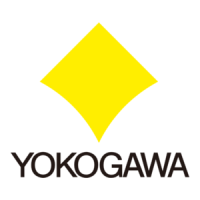3-3
IM CW120-E
Precautions for Safe Measurement
3
3.2 Installation Procedure
Install the CW120/121 in a location that satisfies the following conditions.
● Indoors
● Ambient Temperature and Humidity
• Ambient temperature: 0°C to 50°C
• Ambient humidity: 5 to 85% RH (no condensation)
● Altitude of Location
• Altitude: 2000 m or less
● Overvoltage Categories (CAT.)
“Installation category (Overvoltage category)” describes a number which
defines a transient overvoltage condition. It implies the regulation for
impulse withstand voltage.
INSTALLATION CATEGORY (OVERVOLTAGE CATEGORY) II:
Local level, appliances, PORTABLE EQUIPMENT etc., with
smaller transient overvoltages than INSTALLATION CATEGORY
(OVERVOLTAGE CATEGORY) III.
INSTALLATION CATEGORY (OVERVOLTAGE CATEGORY) III:
Distribution level, fixed installation, with smaller transient
overvoltages than INSTALLATION CATEGORY
(OVERVOLTAGE CATEGORY) IV.
INSTALLATION CATEGORY (OVERVOLTAGE CATEGORY) IV:
Primary supply level, overhead lines, cable systems etc. This
category is not relevant to this standard.
The CW120/121 meet the following overvoltage categories with the
respective usage voltages.
Voltage measurement circuit: 600 V, CAT III, and 300 V, CAT IV
Power supply: 240 V, CAT II
● Pollution Degree
“Pollution degree” describes the degree to which a solid, liquid, or gas
which deteriorates dielectric strength or surface resistivity is adhering.
“2” applies to normal indoor atmosphere.
Normally, only non-conductive pollution occurs. Occasionally, however,
temporary conductivity caused by condensation must be expected.
The CW120/121 meet the “Pollution degree 2”.
CAUTION
• When using or installing two or more CW120/121 power meters, leave a distance of at least 10
mm (0.4") between them.
• When putting a power meter inside a power distribution panel or the like, leave a space of at
least 10 mm (0.4") from a wall and ensure that excess pressure may not be applied to the
protruding plugs and jacks on the terminals.

